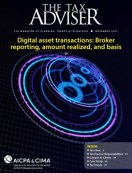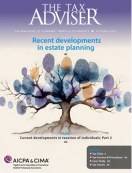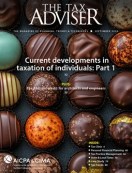- newsletter
- TAX INSIDER

Using donor-advised funds in 2021 (and beyond)
Donor-advised funds have increased in popularity because of recent legislative changes that affect charitable giving.
Please note: This item is from our archives and was published in 2021. It is provided for historical reference. The content may be out of date and links may no longer function.
Related
Social Security wage base, COLA set for 2022
Donor has no standing to sue donor-advised fund
Replacing your ‘how’ with a ‘why’ approach to PFP services
This article discusses donor-advised funds, which have become increasingly popular because they offer a workaround for a complication that a recent legislative change has introduced to charitable giving.
Securing a tax benefit for charitable donations used to be a fairly simple task for middle- to upper-income taxpayers who itemized deductions — they simply included their donations on Schedule A, Itemized Deductions. Often, the main challenge was finding the receipts.
The situation became more complicated in 2017, when the law known as the Tax Cuts and Jobs Act (TCJA), P.L. 115-97, increased the standard deduction and also capped the deductible amount of state and local taxes at $10,000. These changes made the standard deduction greater than itemized deductions for many taxpayers, and, as a result, the number of households claiming an itemized deduction for their charitable gifts fell by approximately 20 million, according to the Urban-Brookings Tax Policy Center. (Note that, for 2020 and 2021 only, the Coronavirus Aid, Relief, and Economic Security (CARES) Act, P.L. 116-136, gave filers who take the standard deduction the option to deduct $300 of cash contributions ($600 for joint filers in 2021)).
At the same time, the CARES Act gave taxpayers who donated cash a significant break by allowing them to deduct up to 100% — rather than 60% — of their AGI for cash contributions to qualified charities in 2020. This larger tax benefit for charitable giving (extended to cover 2021 contributions also) only applies to those who itemize.
In order to increase their itemized deductions to an amount above the standard deduction, many taxpayers use a strategy known as bunching, in which they concentrate two years of charitable contributions in one year. The taxpayer itemizes deductions in the contribution year and gets an increased deduction for his or her charitable contributions in that year, while taking the higher standard deduction in the year without contributions. “People are looking at itemizing every other year with the standard deduction so high now,” said Mary Kay Foss, a recently retired CPA who advised middle-income filers in northern California.
However, while wanting the tax benefit of making large contributions in one year, many taxpayers also want to spread out when the charity actually receives the contribution over a longer period. Enter the donor-advised fund (DAF), which allows a taxpayer to achieve both of these objectives.
Donor-advised funds
With a DAF, an account holder can put assets into a fund managed by a professional brokerage or other entity and recommend which organizations they would like to receive the funds. “The beauty of the DAF,” Foss noted, is that a full deduction can be taken in one year, while the contributions may be spaced out over a much longer period.
DAFs, unlike charitable remainder trusts or private foundations, require minimal administrative work on the part of the donor and are relatively simple and cheap to establish. “People love DAFs,” said Sue Stevens, CPA/PFS, who advises high-net-worth individuals for Buckingham Strategic Wealth in Deerfield, Ill. “It’s all organized, there are no legal fees, and [it works for] all levels of wealth.”
Not surprisingly, these funds have rapidly become a tax vehicle of choice. The National Philanthropic Trust revealed that individual DAF accounts jumped by 19% between 2018 and 2019, bringing the total number of DAFs to 873,228.
“It’s something a family can do,” Foss said, adding that one of her clients set up a donor-advised fund at a local hospital for people to donate in honor of his deceased wife. Stevens concurred, stating that DAFs offer donors an opportunity to involve their children in deciding what kinds of causes to support. They are also useful for individuals who experience a one-time windfall and want to minimize the tax pain.
While DAFs offer convenience and other advantages, donors have less flexibility and control than they would writing a check. According to Lisa Featherngill, CPA/PFS, director of Wealth Planning at Comerica Bank in Winston-Salem, N.C., while brokerages or sponsors typically accommodate recommendations to grant contributions to a certain group, there is no guarantee. Also, DAF participants cannot derive any personal benefit from a grant they request, such as tickets to a charity ball they used to attend.
Not all charities are enamored of DAFs, as they are not getting funds fast enough, Stevens said. Many back a Senate bill that would, among other things, permit a full deduction only if the funds are distributed from certain DAFs within 15 years of the donation.
Factors to consider
Planners working across income spectrums offered suggestions on issues to raise when advising charitably inclined clients on whether and how to use DAFs.
- Donation amount and fees: The minimum dollar threshold for a DAF can define the choice for some. “Vanguard tends to be lower cost in general,” said Deborah Meyer, CPA/PFS, owner of WorthyNest in Fort Myers, Fla., but the minimum to start an account is $25,000.
- Type of asset: This factor alone can clinch the decision between a larger DAF brokerage such as a Schwab or Fidelity versus a local fund. “Small charities may only be set up to accept cash or check,” Meyer remarked. If the client is looking to give appreciated stock, property, or even bitcoin, the bigger brokerages will take it.
- Motivation: Is the client looking to make a local impact or are they more interested in national or global causes? Featherngill sees a big advantage to a community DAF because the foundation “really understands the need of the community.” Another possibility, raised by Meyer, is University Impact, a not-for-profit that offers customized DAFs based on clients’ impact, geographic, and investment preferences.
- Timing: Start early in helping clients establish one. “Don’t want until December,” Stevens warned. “There will be a huge group of people trying to get money in” before the tax year ends. Also, for smaller charities, spacing out contributions over regular intervals can help them with cash flow concerns.
- Income gains: “DAFs work great for someone who wants to ‘frontload’ a charitable contribution” to offset a windfall, Featherngill said, citing as an example someone who is realizing a significant capital gain from selling a business.
- Management of the DAF: “Personally, I feel more comfortable with larger [organizations],” Meyer said, citing their higher public visibility and oversight. Featherngill noted that local groups may have relationships with investment firms that can provide quality management, adding “if the donation is significant enough, you may be able to have who you want” handle the funds. Regardless of size, advisers will want to explore the reporting, performance, and governance of DAFs they recommend.
- Succession: Encourage clients to name successors of the DAF, and review that list with them annually.
Looking to the future
DAFs and other giving techniques will become even more popular if certain tax increase proposals before Congress as of this writing are enacted into law, such as raising capital gains tax rates. Featherngill, in a July interview, thought it was too early for the proposals to affect giving strategies. But if the tax hikes become law, “I see charitable gifting being incorporated even more heavily than it is today” into financial planning as efforts to lower capital gains and taxable income will kick into high gear.
AICPA resources
“Getting Ahead of the Biden Administration’s Tax Proposals” (video): Key topics include timing ideas, charitable gifts, harvesting gains, and Roth conversions. (PFP Section members only.)
“Charitable Giving Strategies” (video): Learn from a high-net-worth adviser about donating appreciated stock to maximize potential tax benefits.
“Private Foundations and Donor-Advised Funds: A New CPA Best Practice“: This Tax Adviser article compares the pros and cons of these charitable giving structures.
— Ann Marie Maloney is a freelance writer based in Virginia. To comment on this article or to suggest an idea for another article, contact Dave Strausfeld, senior editor, at David.Strausfeld@aicpa-cima.com.














